“Hey! There’s a rattlesnake out here!” Yeah……..sure, I thought. Having just concluded a reptile presentation for some Yuma 4th graders visiting Imperial National Wildlife Refuge, I knew that they were thinking snake thoughts. And one of our snakes I had shown them could easily be mistaken for a rattlesnake.
But when I emerged from the visitor center to check it out, to my amazement — and their satisfaction — the reptile under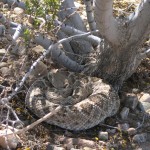 the creosote bush was, indeed, a four foot western diamondback rattlesnake. This desert dweller was content to remain coiled in the bush’s cool shade. However, since that particular creosote was a scant 25 feet from tables full of 10-year-olds, I decided to remove the danger from an otherwise comfortable picnic of peanut butter sandwiches, apples, and a cookie.
the creosote bush was, indeed, a four foot western diamondback rattlesnake. This desert dweller was content to remain coiled in the bush’s cool shade. However, since that particular creosote was a scant 25 feet from tables full of 10-year-olds, I decided to remove the danger from an otherwise comfortable picnic of peanut butter sandwiches, apples, and a cookie.
Proper Equipment
I searched for my snake tongs, snake hook, and a large plastic trash can with a lid. Then, while teachers kept the students at a safe distance, I approached the snake to relocate it for the safety of Refuge visitors, as well as for the snake’s safety.
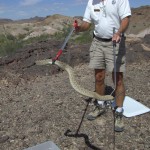
With other ideas, however, the snake slithered down the hill toward the picnic tables, increasing the concern for safety and the possibility of evacuation of the picnic area if we lost visual contact. Fortunately, my persistence paid off and I was able to control the rattler with the snake hook and place it gently into the trash can. The danger removed, I placed the container in the back of a pickup to await transfer to its new home.
New Home
The new home was not all that far from where the pit viper was found, but far enough to keep it a safe distance. Some people would be quick to say, “Let’s take it a few miles from here and be done with it.” Studies have shown, however, that most snakes relocated more than a mile or two from their capture point have less than a 50% chance for survival, mainly due to not knowing the new territory and its hunting grounds.
To hunt, rattlesnakes coil beside a rodent trail and pick off rats and mice that travel a common route. That’s one of the reasons these snakes have been so successful for millions of years. On the other hand, their look-alike cousins, gopher snakes (also called bullsnakes) actively hunt their prey by poking into holes, burrows, and even birds’ nests.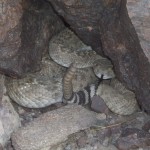
As I relocated the rattlesnake, at no time did it act aggressively. Its main interest was fleeing the area after being discovered. The minute it was released from the trash can, it made a beeline into a nearby rock pile, away from human contact.
Other Opportunities
This was only one of the opportunities I’ve had to relocate rattlesnakes at the Refuge. When visitors report a snake or when locals call to ask to have one removed from their property, I am more than willing to respond. I appreciate their concern for the welfare of the snake as much as their own.


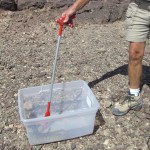
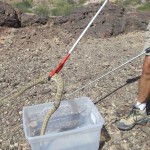
Good article, and thank you for moving it.
I have a den of blacksnakes in my house. My husband need to relocate them – how far should he take them so they do not return. Thanks for your response.
Hello Ethel,
You didn’t say exactly where you live, but it appears you’re in northern MD. The weather outside is not conductive to snakes or other reptiles, but with the warming that should happen soon snakes will begin appearing and perhaps leaving your house. Not sure if the blacksnakes you have in the house are adults living together for the winter or newly hatched offspring. I’m thinking as the weather warms, they may leave “home” on their own. But if you absolutely need them gone, I’d recommend that you try to wait for a sunny day to make the transfer. As I mentioned in our article, anything more than a mile from the point of capture could prove to be a challenge to survival to the snakes. However, my feelings are that if you move them within a mile, hopefully in a wooded area or near a waterway, they most likely wouldn’t return to your house. And, I’m wondering how they got into your house….are they in a basement, is is an older house with many holes/cracks in the construction for their entrances? Have you seen any mice or mice droppings inside the house….they would be a real snake magnet. If you had a mouse problem, removing them (mice) usually would mean the snakes would not return due to an abundance of food outside where they belong. If you do decide to relocate the blacksnakes, I suggest that you would use a plastic garbage can and broom to urge them into that. Then cover the top, take can and snakes outside and release at that point. I appreciate your taking the time to ask an important question and hope that both you and the snakes will succeed in your respective habitats! Thanks again for writing!
If they are newly hatched offspring they have not established a territory yet and moving them far away does not decrease their survival rate.
Good point. Thanks for sharing.
Thanks ! The article is great . Thanks for the info.
Thanks, Chester! We’re glad you enjoyed the article.
Do you have links to the studies?
I asked because I have found quite a few studies that challenged the notion that long distance relocation equals a death sentence.
I frequently See it stated that there are “multiple studies” that prove the opposite and yet no one seems to provide links or a bibliography so I am curious what this long-standing belief is based on.
I’m not aware of any definitive documentation regarding relocation of snakes and the suggested distances from their capture. I do know, however, that from personal experiences that the chance of success could diminish the further from “home” the release occurs. It’s a tricky situation: leave the snake where it is found, often subject to abuse or violent death or provide at least a chance to attempt a normal life cycle away from human interference. A great site to further investigate your concerns would be rattlesnakesolutions.com, an Arizona company that documents thousands of snake removals and releases. Their interest (on YouTube) revolves around the proper, carefully removing of the local snake population from harm’s way. Not always an easy task when located in a growing metro area. They have my greatest respect.
So in your personal experiences you have seen that Snakes moved far away do not survive? Data is great but there’s also case studies and obervation. 😏
Since you asked, I personally have not documented whether or not snakes moved from a distance from capture have a lower survival rate than if they were closer to capture site. However, for over 40 years working with various local, state and national agencies, the comment that has been pervasive was/is that it’s better, obviously, to release the snake closer to that site. I’m sure you’ve deeply scrutinized case studies and would appreciate your sharing them with this blog for the sakes of our local snake population. Unlike NC, here in the Desert Southwest, particularly Arizona, there has been an astronomical increase of land development resulting in snakes and other wildlife being displaced or locally extirpated. What appears to be a suitable relocation spot today, could, in less than a year, see total habitat destruction. There is no PERFECT solution. Perhaps, in North Carolina, you have the luxury of limitless safe habitat. There’s no set rule unfortunately in relocation. We both share the same passions and desires to protect all wildlife and the whole environment as well.